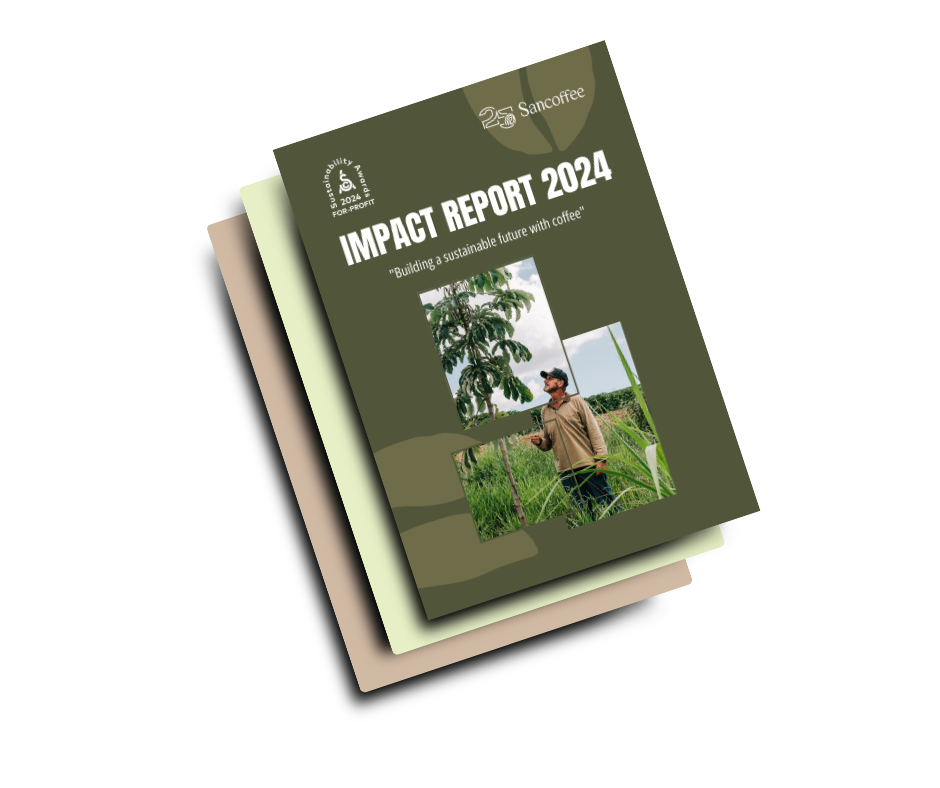Taking the responsibility for Co2 impact to mitigate Climate Change
In the last years we observed that the coffee industry has been directly affected by severe droughts, hailstorms, frosts, and storms, which interfered with the physiological cycle of the coffee plants, and consequently with the production. Under the framework of the Paris Climate Accords of 2015, national governments have made strong commitments to take action not to allow a temperature increase above 2°C compared to pre-industrial levels. In order to achieve this goal, it will be necessary for all stakeholders to work collectively to mitigate Climate Change.
We believe that every business must measure their carbon footprint and take responsibility for reducing their Co2 impact. Sancoffee began measuring emissions and removals back in 2020 and keep growing the scope of the project year after year. Sancoffee partnered with CleverCoffee who share the same values and bring climate initiatives to the core of their business operation.
This year the two companies decided to combine their efforts and calculate the total carbon footprint of one coffee lot across the whole value chain to give the industry and the end customer the most comprehensive overview of the impact generated from farm to cafe.

Carbon-neutral value chain: Fazenda Santa Clara Brazil -> Impact No 01 CleverCoffee
Launched in Q1 2023 in collaboration between Sancoffee and CleverCoffee, Impact No 01 is the first Co2 neutral coffee backed by emissions data.

- All data presented represents emissions and removals calculated proportionally for one specific lot (order volume vs total produced and shipped volume)
- The data for the farm’s emission is for 2021 as the 2022 data is still being processed but we don’t expect any significant change due to a consistent environmental policy at all Sancoffee farms
Measurement methodology
The methodology used by both Sancoffee and CleverCoffee was the Greenhouse Gases Protocol (GHG protocol) followed by the guidelines of UN's Intergovernmental Panel on Climate Change (IPCC), and also coffee growing scientific literature.
GHG Protocol establishes comprehensive global standardised frameworks to measure and manage greenhouse gas (GHG) emissions from private and public sector operations, value chains and mitigation actions.
- CleverCoffee’s carbon assessment conducted by the Danish company Force Certification https://forcecertification.com/da/
- Sancoffee’s carbon assessment of all farms was conducted by the Brazilian company Green Solutions https://gron.com.br/
Removals and offsetting
Removals at the farm come from native trees, coffee crops, planted forests, land use change and isolated trees spread across the farmlands.
To offset its operational emissions, Sancoffee purchased credits from The Envira Amazonia Project - A Tropical Forest Conservation Project in Acre, Brazil, validated and verified by Verra Carbon Standard, becoming a Carbon Neutral company.
To offset emissions generated from the part of the chain from Santos port, CleverCoffee purchased carbon credits from Ecologi. From shipping from Brazil to the roastery until packaged and shipped to customers.
You can check CleverCoffee’s individual and smaller regeneration projects on their Ecologi page.
How the two carbon reduction journeys started

What's next
CleverCoffee are always looking for ways to improve the impact. In 2023 they are very focused on reducing energy consumption in the brewing process, with their introduction of a full boilerless coffee setup for both espresso and batchbrew coffee. This makes it possible to reduce the energy consumption by around 90 percent.
At the same time CleverCoffee are looking into methods to help coffee farmers to calculate ther carbon footprint, without this being costly and time consuming. This is not an easy task, but a very important one, to meet the expectations from the European B2B customers.
Sancoffee’s long term vision for this project is to help the environment to be in good balance with human beings, by using more conservationist farming techniques, recovering vulnerable areas (bio recovery) and reducing and insetting all our Carbon footprint and offering our roasters the surplus we will be generating.
Download Sancoffee Impact Report 2024
Get your copy of the latest Impact Report to learn more about the progress we made in 2024 in the area of ESG (carbon research, bio recovery, female and small holders empowerment and much more)

Check out the Net Zero page of CleverCoffee
Go the dedicated page about the Net Zero initiative to learn more about the company's impact agenda and core values

Would you like to learn more about Sancoffee and our coffees?
Send us a WhatsApp message and we will be happy to arrange a chat and tell you more about the fresh crop.

